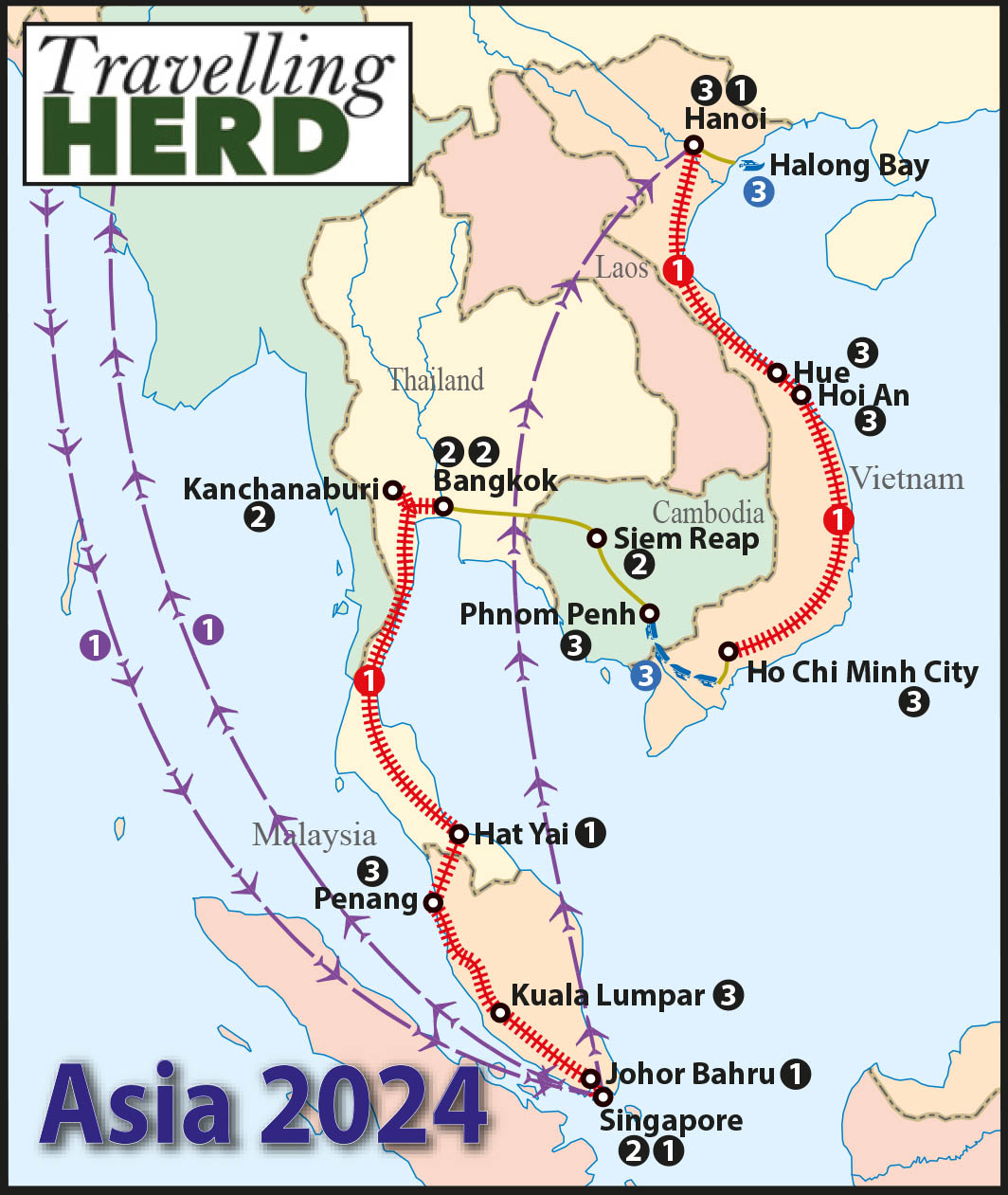Read this blog: The one where we find Matilda’s legs are too short
Monday 18th March 2024
In 1885, or possibly 1889 depending on the historical source, French archaeologists claimed credit for discovering the Mỹ Sơn Sanctuary, a cluster of abandoned and partially ruined Hindu temples and associated buildings. Frenchmen Louis Finot and Launet de Lajongquere began the first excavation in 1898-99, work which was subsequently continued by their compatriot Parmentier between 1903 and 1904.
Built between the 4th and the 14th centuries by the Kings of Champa, the site comprises eight main groups of 71 ruined temples and monuments in Quang Nam Province, in central Vietnam. The Cham people drew on Hinduism from India for their spiritual beliefs and the site is thought to have been the Champa religious and political capital for most of the Champa Kingdom’s existence.
We arranged to hire a car to take us to the site, wait while we looked round and then drive us back.
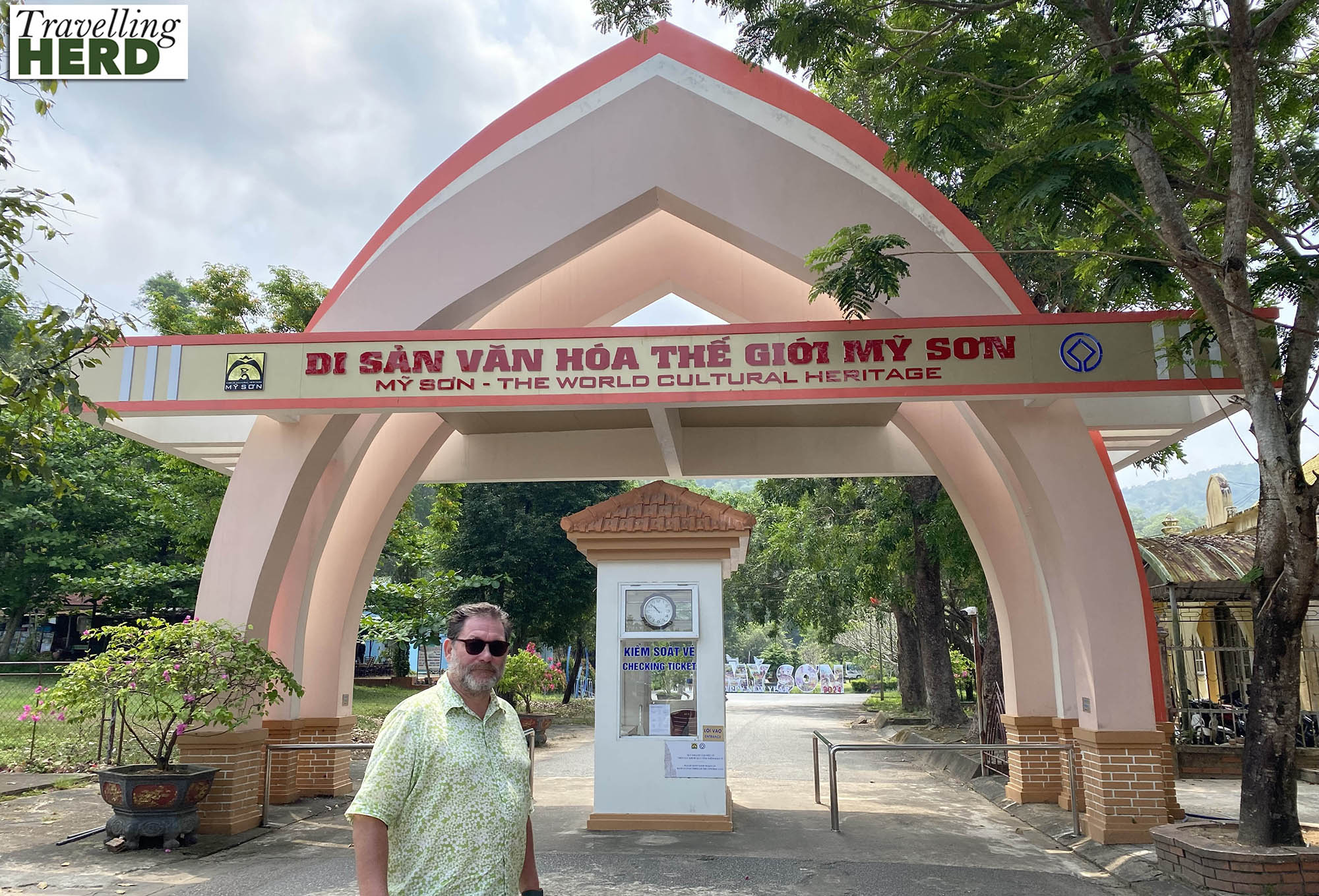
To the right beyond the entrance there is a museum, including many of the artefacts found at Mỹ Sơn. The entrance itself is some way from the ancient monuments and we were thankful for the free electric shuttle service which takes visitors between the museum and the site.
The groups of buildings have been rather unimaginatively labelled using letters which we assume correlate to the order in which the French archaeologists found them. Within these groups, individual buildings are given numbers. Unfortunately this system does not offer any easily distinguishing pointers to their identity, so although Matilda tried to keep track of the order in which we saw the temples, looking back over the photographs it was difficult to be sure we had identified them correctly. Where we are sure, we have captioned the photos accordingly.
We were directed along a one way route, although not all visitors obeyed the signs, and the first group of ruins on the route was Group K. A sign explains that Group K is an example of simple architecture with a small sanctuary to the east.

A modern path leads you around the site from group to group.
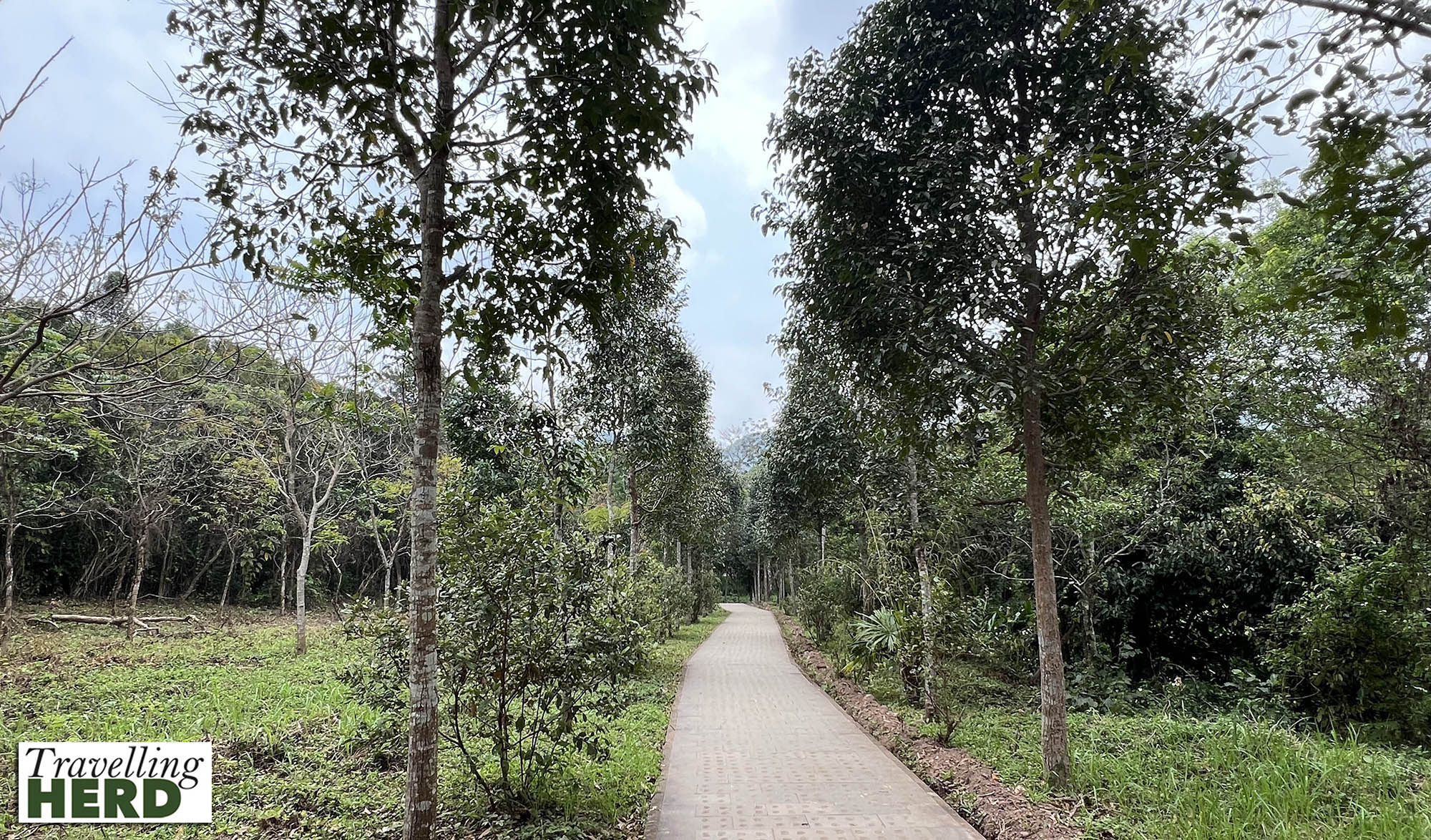
The next ruin we came to was E1 which was built between the seventh and eighth centuries.
The temples in Mỹ Sơn were used by the Viet Cong and the People’s Army of Vietnam [PAVN – Northern communist forces] which prompted the United States to carpet bomb the area over a single week in August 1969, leaving bomb craters and destroying many of the structures which the French had started to restore. Unexploded ordinance still poses a threat in some of the surrounding areas.
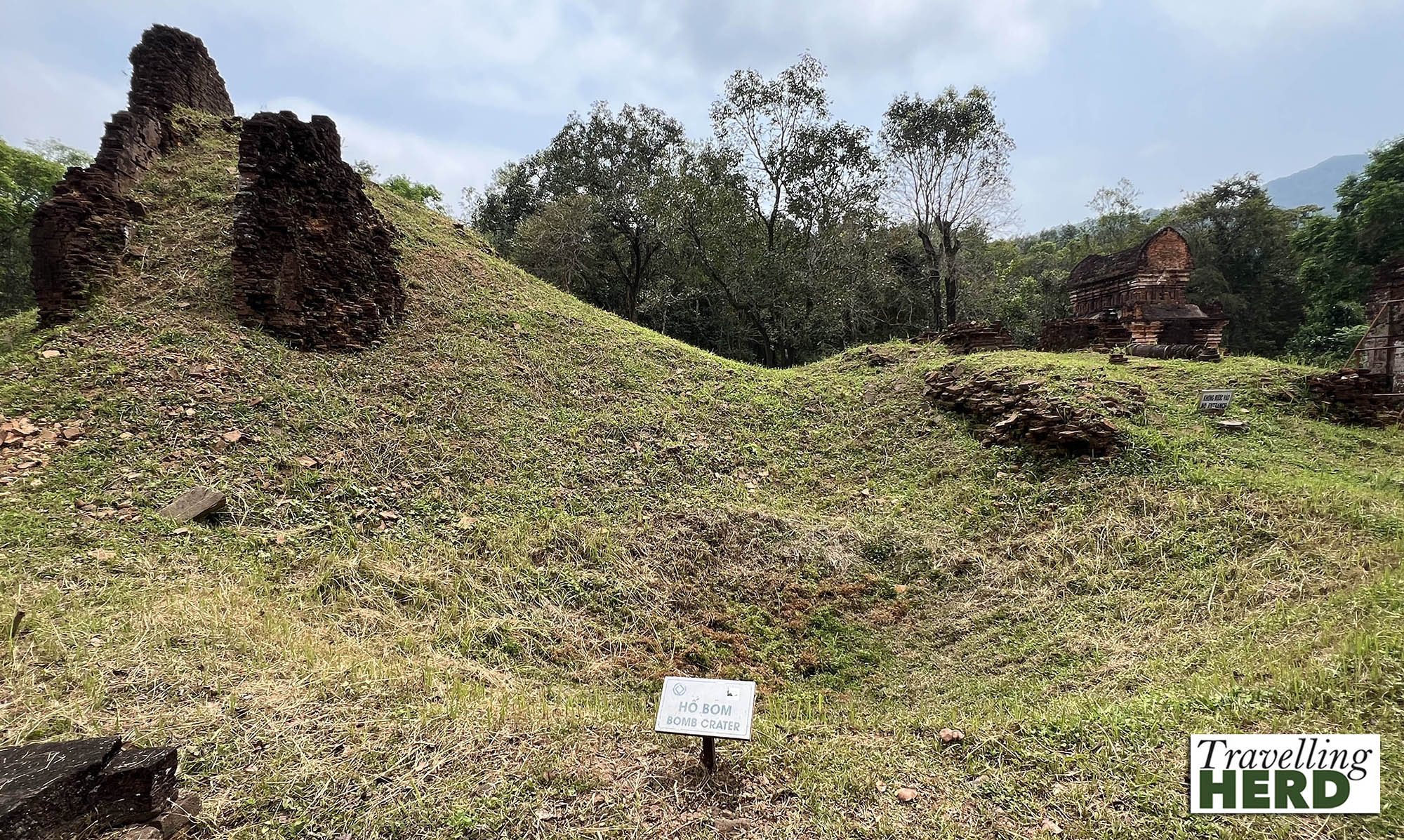
As well as the ruins which can be seen above ground, excavations are on-going to uncover elements which have lain buried for years and which give an insight into the historic development and growth of the Champa Kingdom and the order in which the temples were built.
Currently F1 is a working archeological site, and was extensively damaged by US bombs.
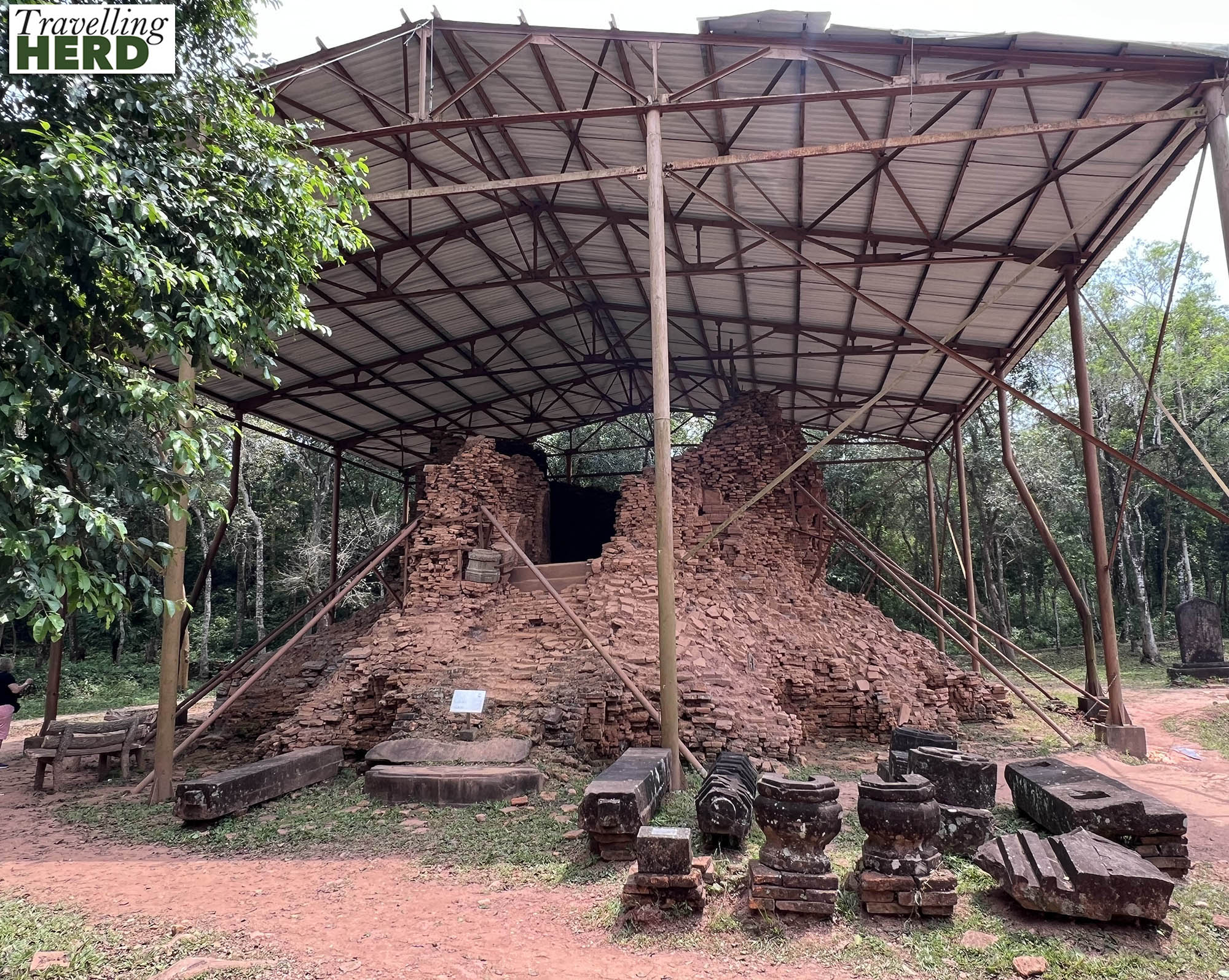
E7 was a library for sacred books or kosagrha.
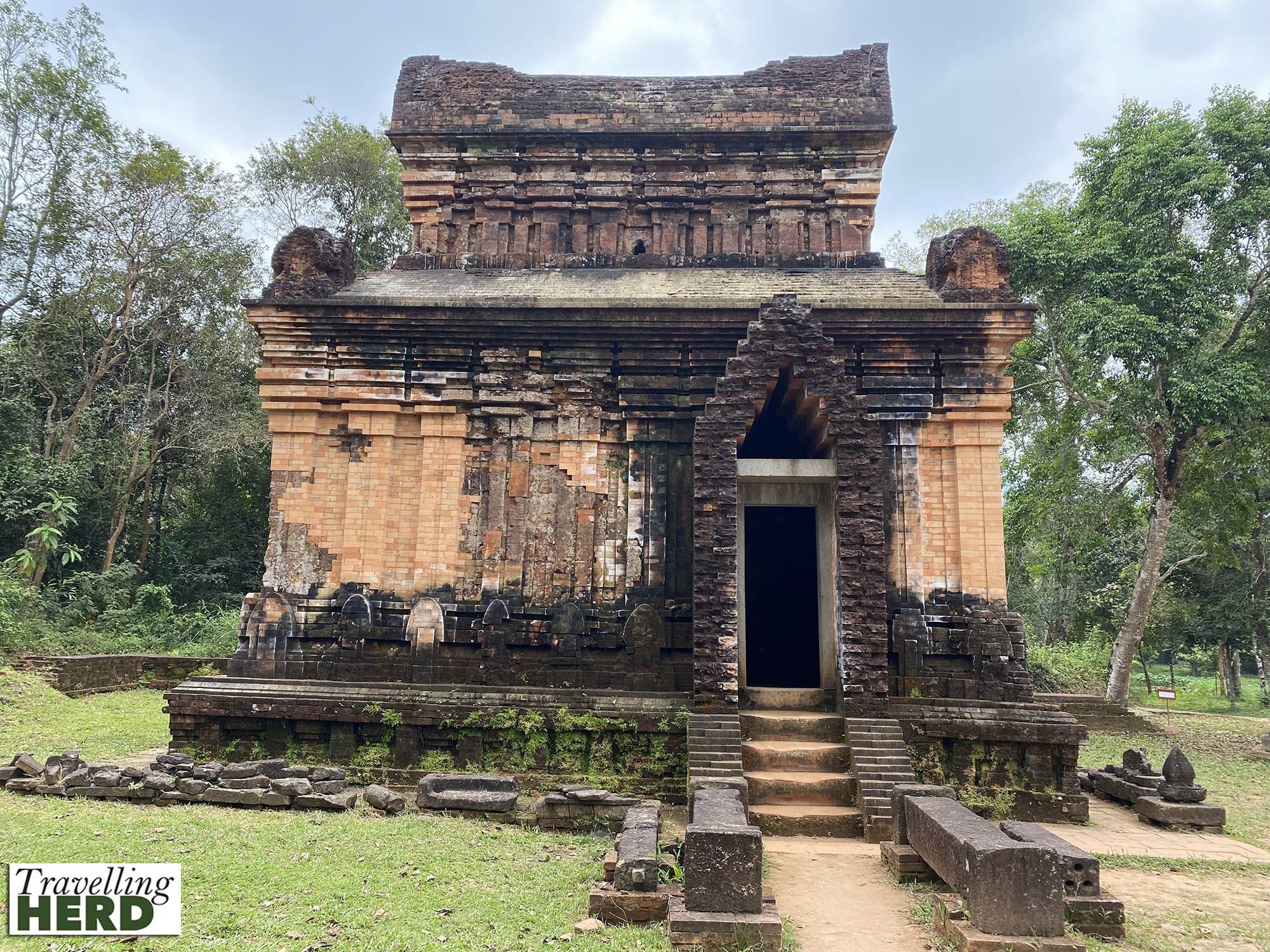
The kosagrha was restored [following extensive damage by US bombs] by a team of Italian archaeologists at the turn of the twenty-first century using Parmentier’s records from 1909. The new bricks used in the restoration are lighter in colour to differentiate ancient from new.
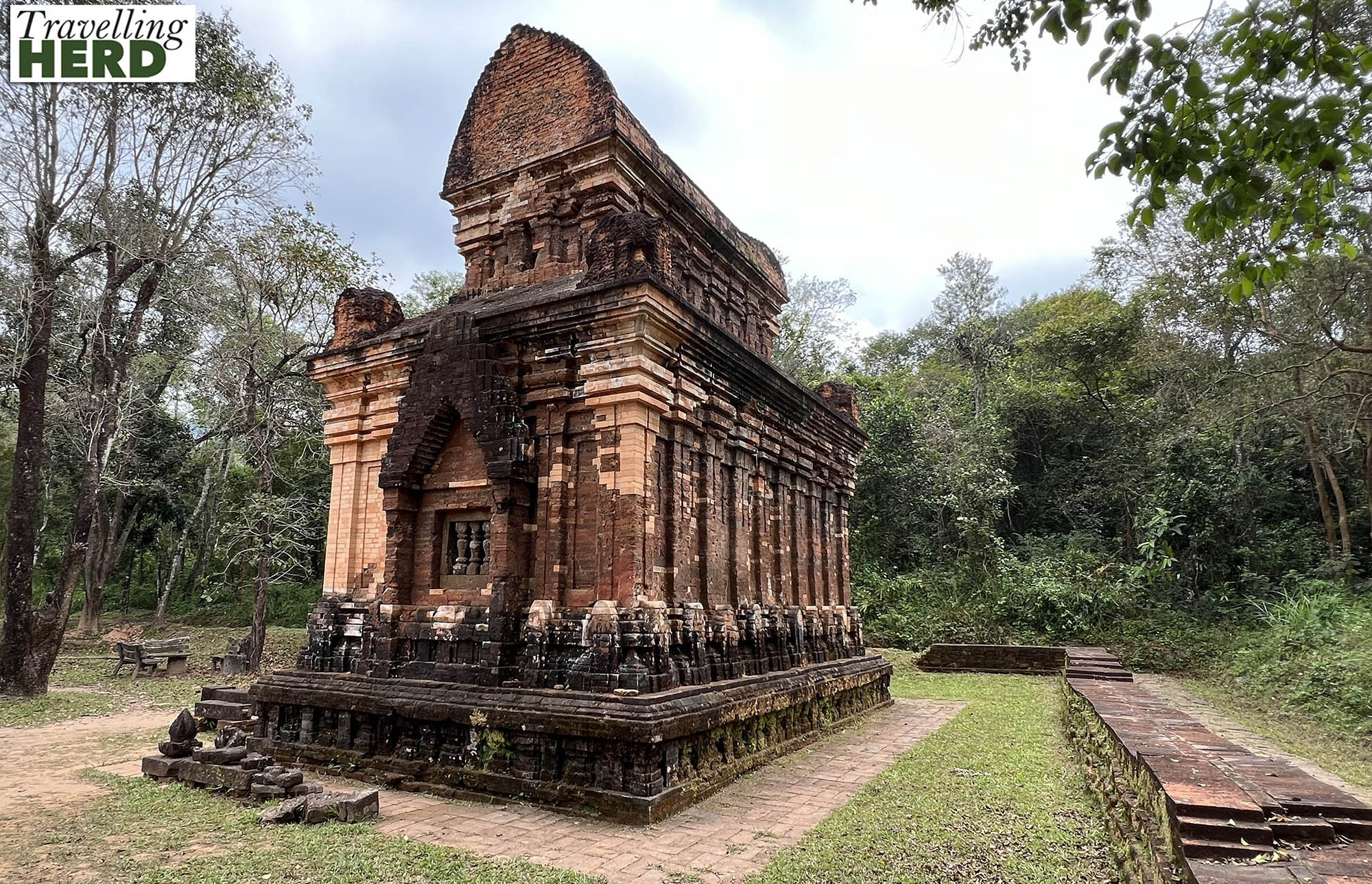
The next stop on our route was group G where the buildings show the influence of Khmer [Cambodian] architecture of the time. The main sanctuary in this group, G1 has three doors and features 52 beautiful dramatic carved terracotta masks around the base of the shrine.
They all represent Kala, the god of time which is an incarnation of Shiva.
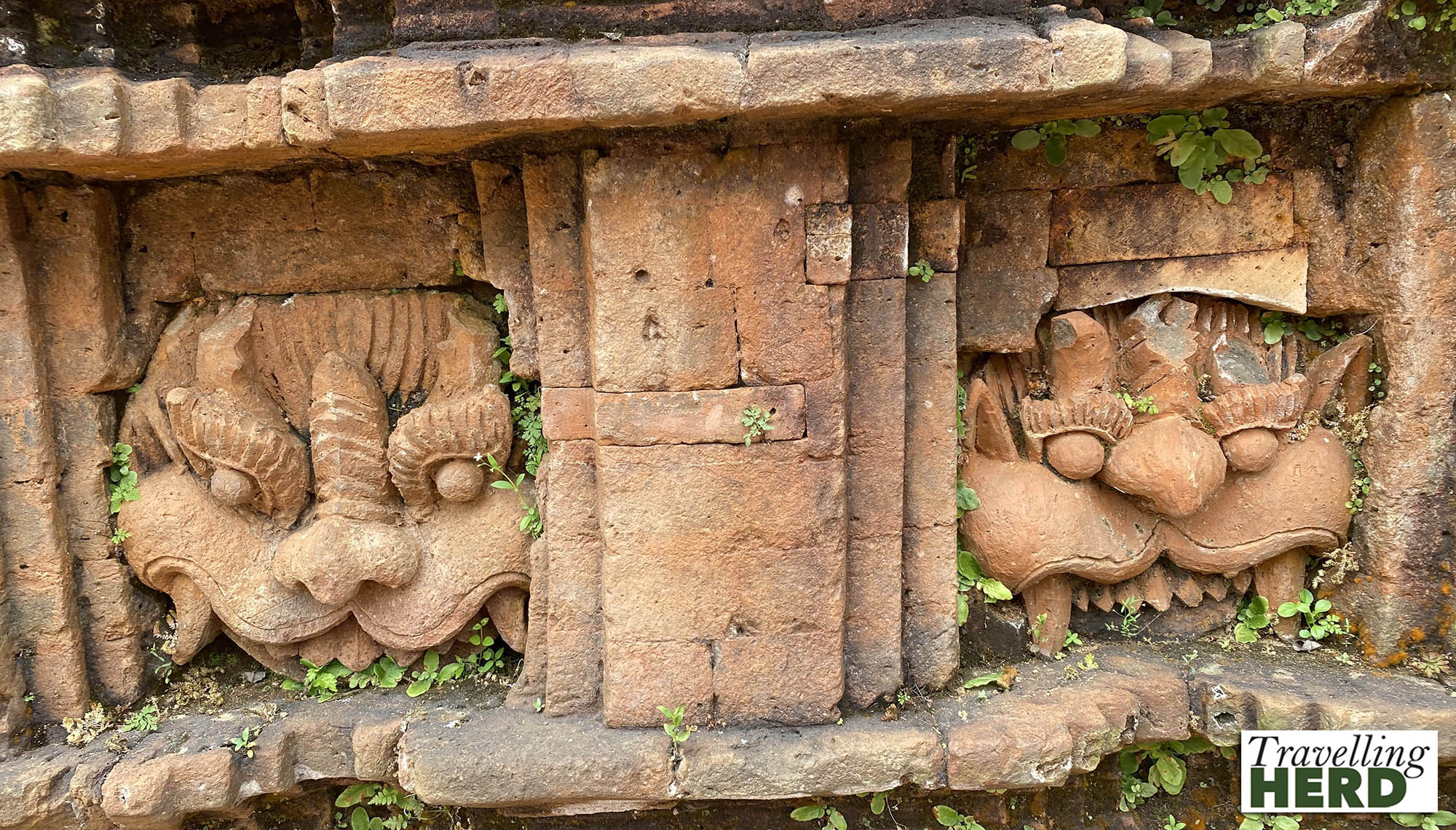
The buildings were constructed using fired bricks of different shapes, fitted together like a jigsaw puzzle, with stone pillars. Decorative sandstone carvings depict scenes from Hindu mythology.
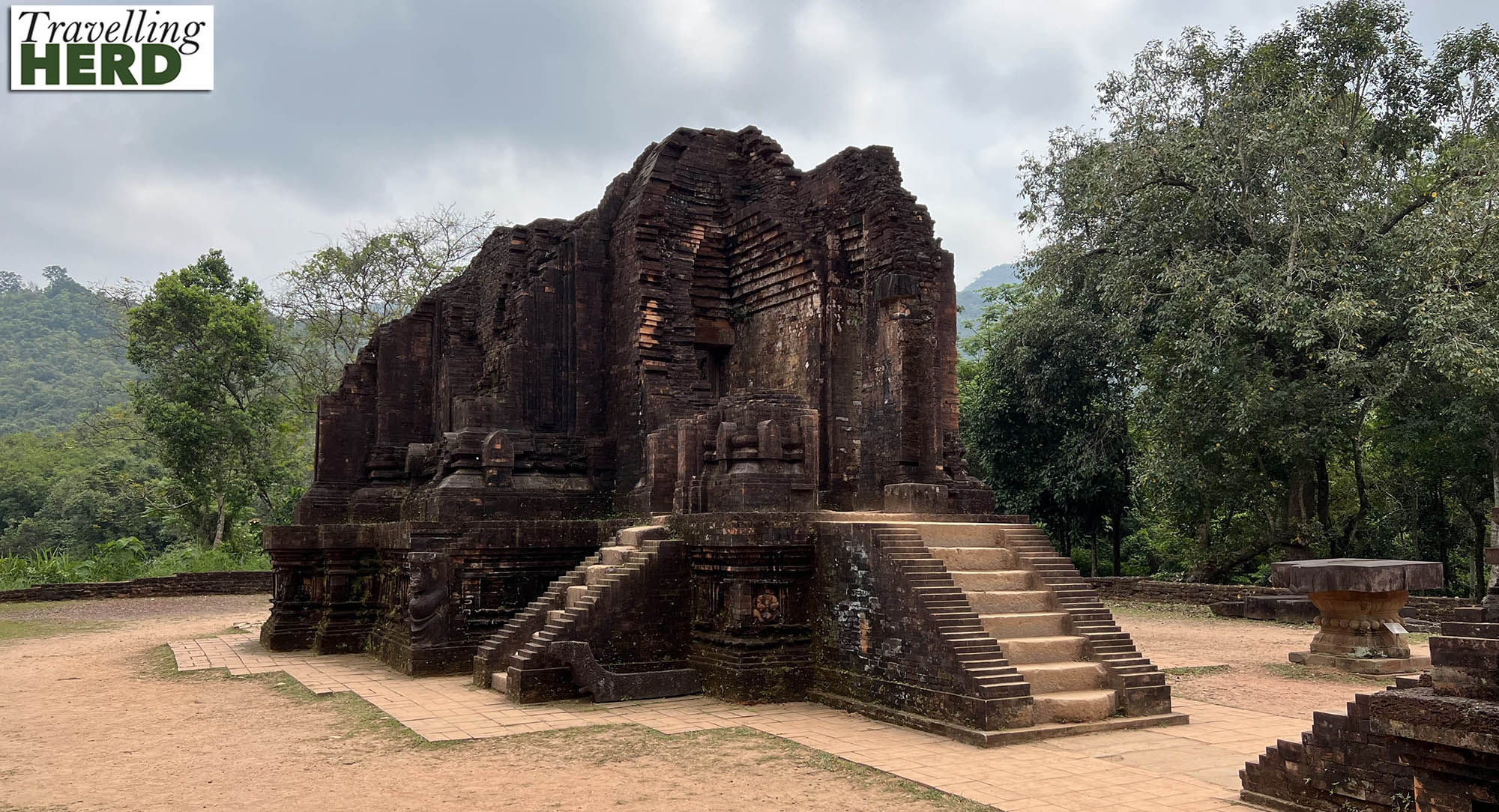
The site lies within a basin surrounded by a ring of mountains, and is the source of the Thu Bồn river which flows down to Hội An. It would have been both strategic and easy to defend.
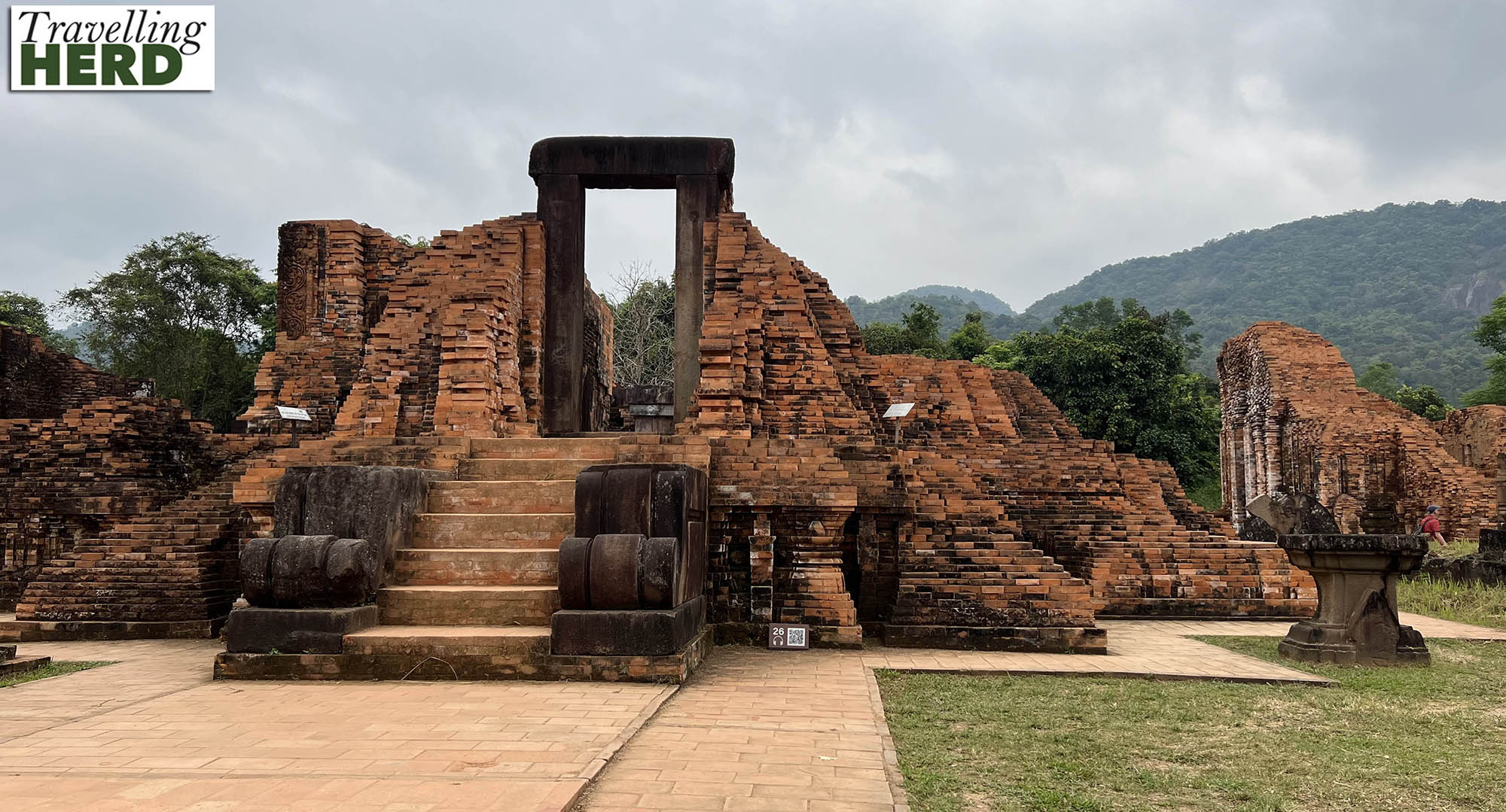
Although the site was busy when we visited, with a little patience and careful camera angles, Robert managed to make it look as though Matilda was almost alone.
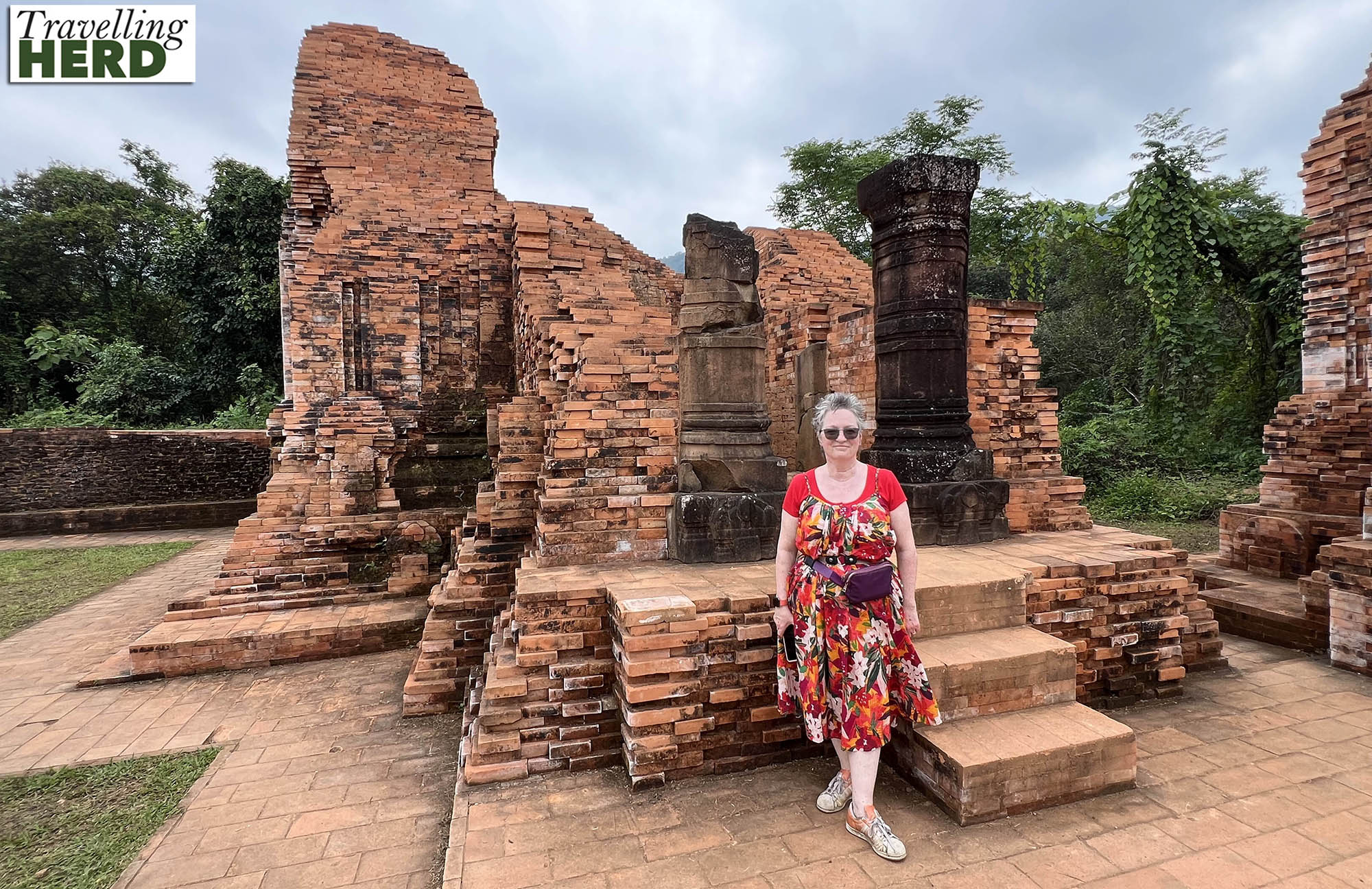
In the last group the main temple had no windows.
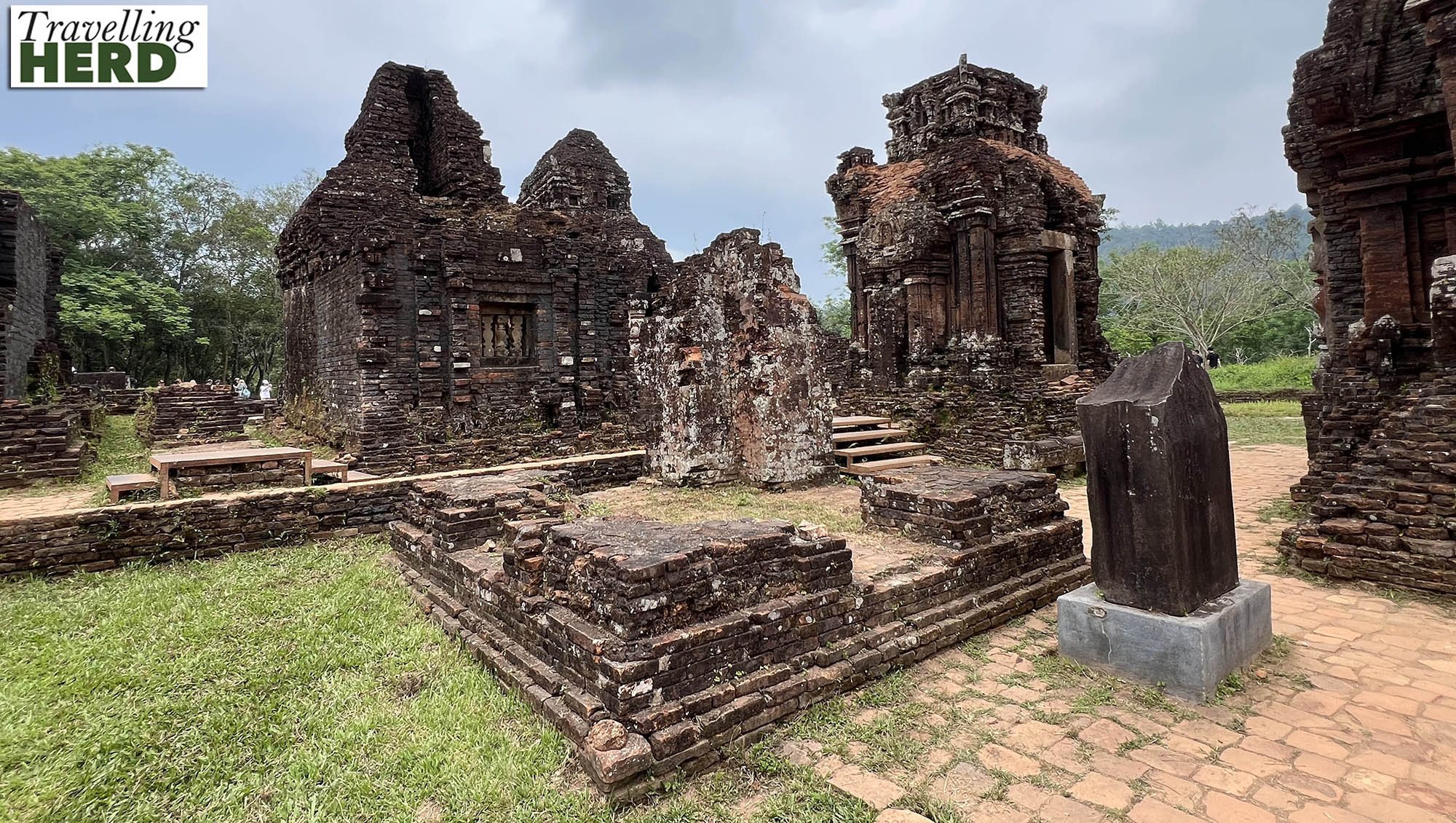
A koshaghara functioned as a storehouse for offerings.

UNESCO deems ‘the monuments are unique and without equal in Southeast Asia’ and it was certainly an impressive sight and demonstrated considerable engineering skills.
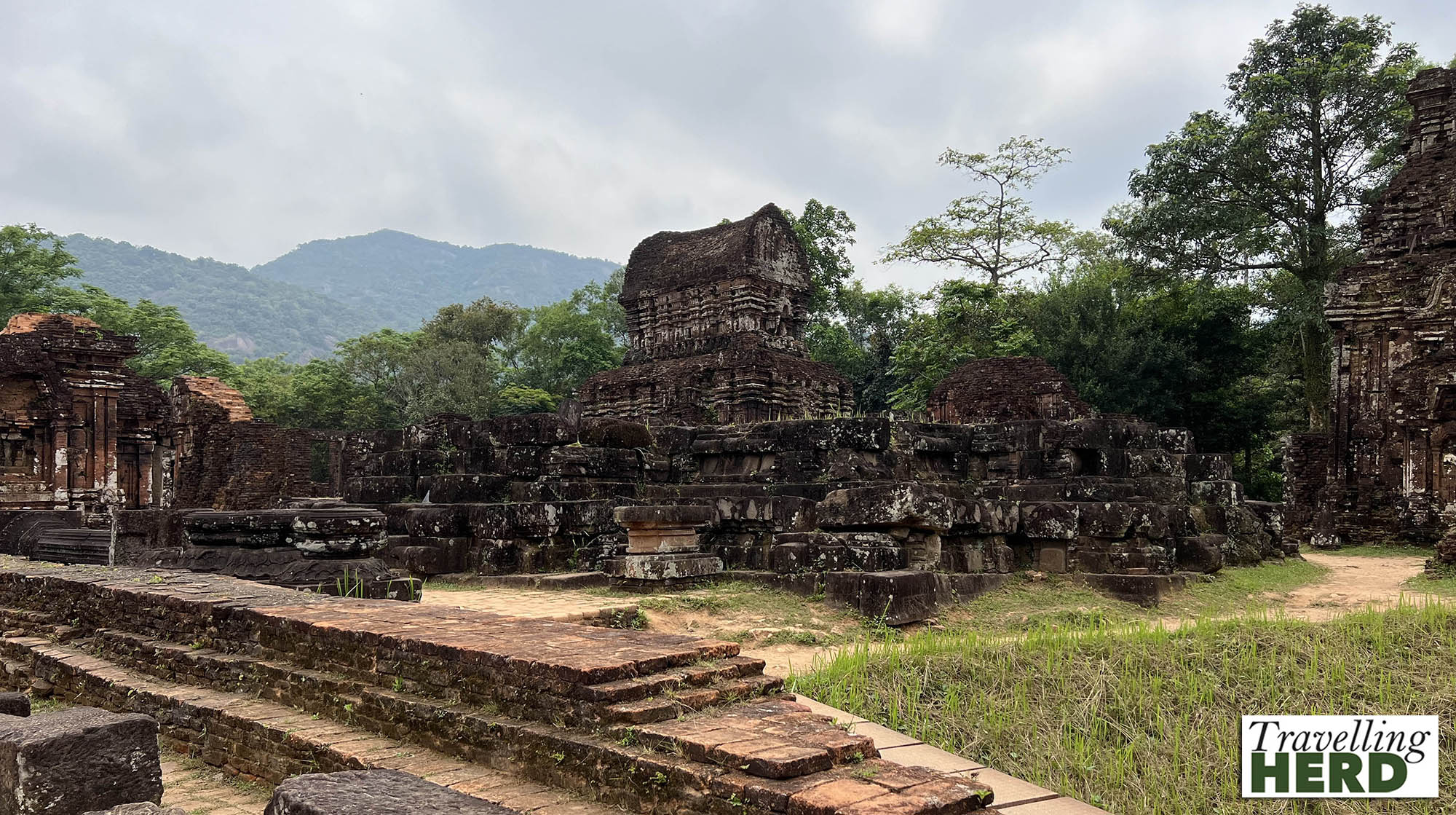
Matilda, however, thought that the people of the ancient Cham Empire were not the only master engineers in evidence. All amongst the undergrowth and in the foliage growing on the monuments themselves, funnel spiders had constructed incredible webs and lurked at the depths waiting for their next meal.
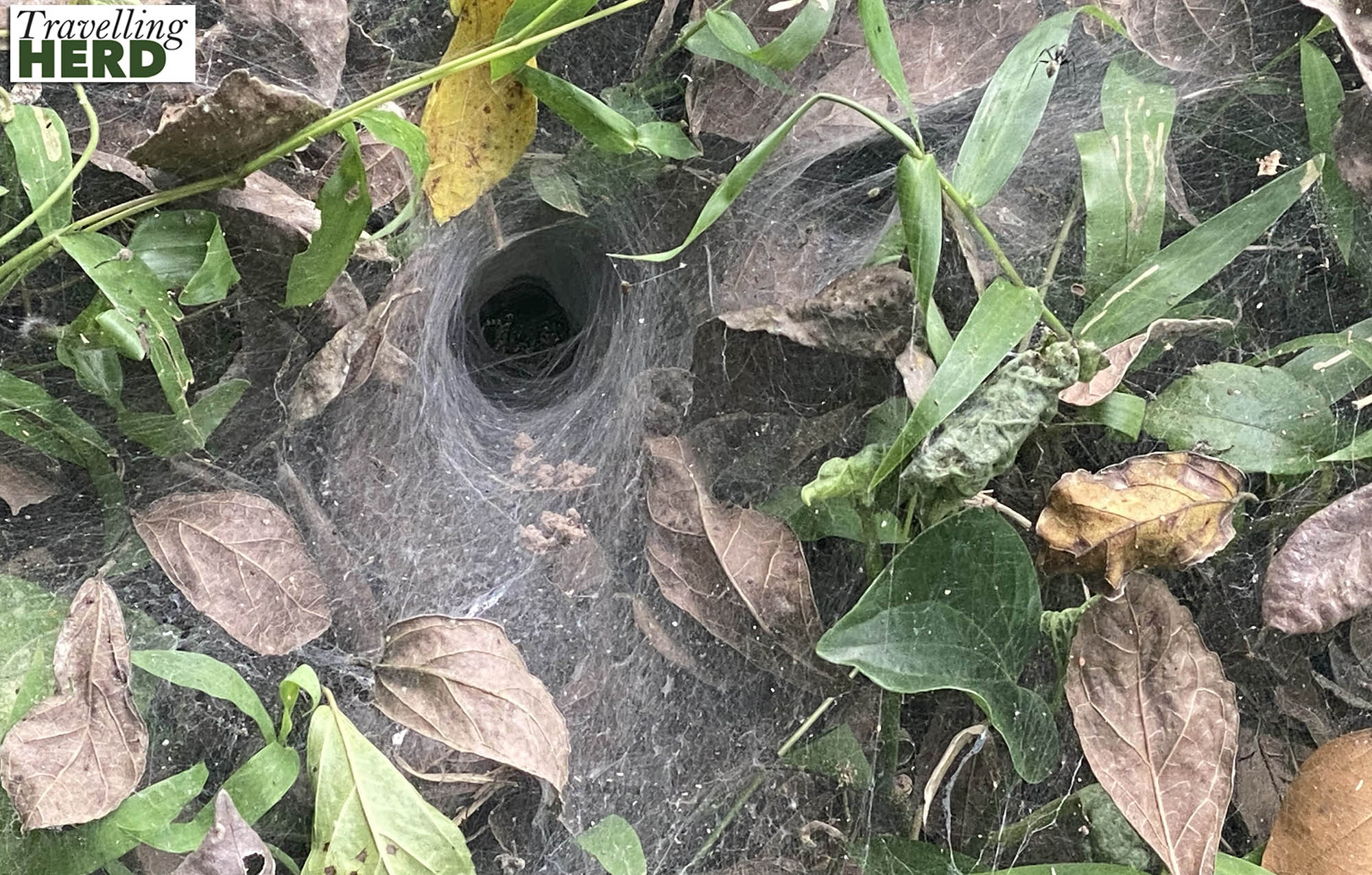
After returning to the 21st century we went to check on the progress of our tailor made clothes. Robert was very pleased with his new Hawaiian shirt. However, an error had been made on one of his formal shirts and this had to be rectified. He was also allowed to choose the accent colour for the buttons. Matilda needed her trousers shortened: it seems even her tailor feels she should be taller.
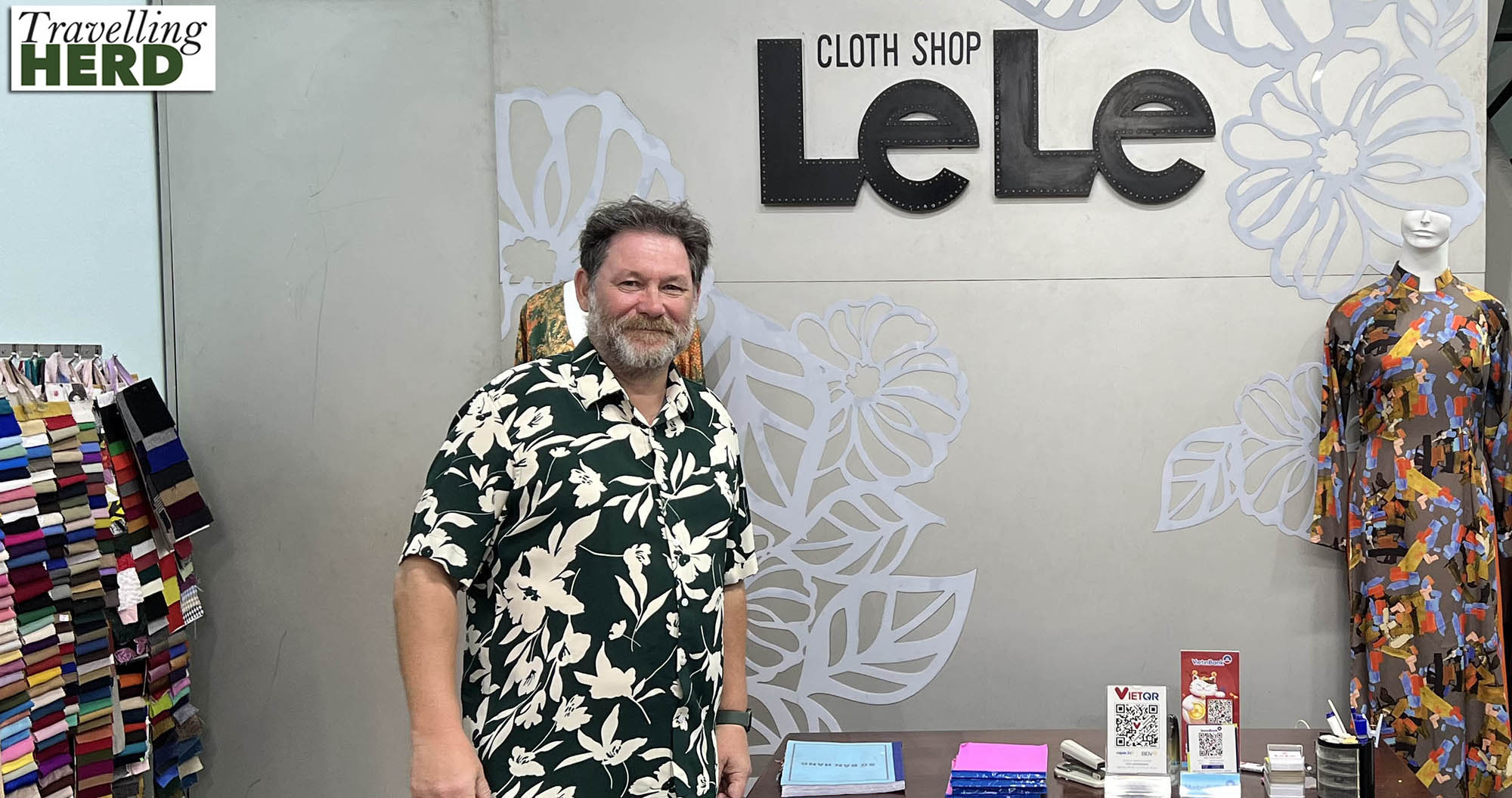
So we left the revised instructions and went on towards the Thu Bồn River again where the boatmen were already convening for the dusk time rush.
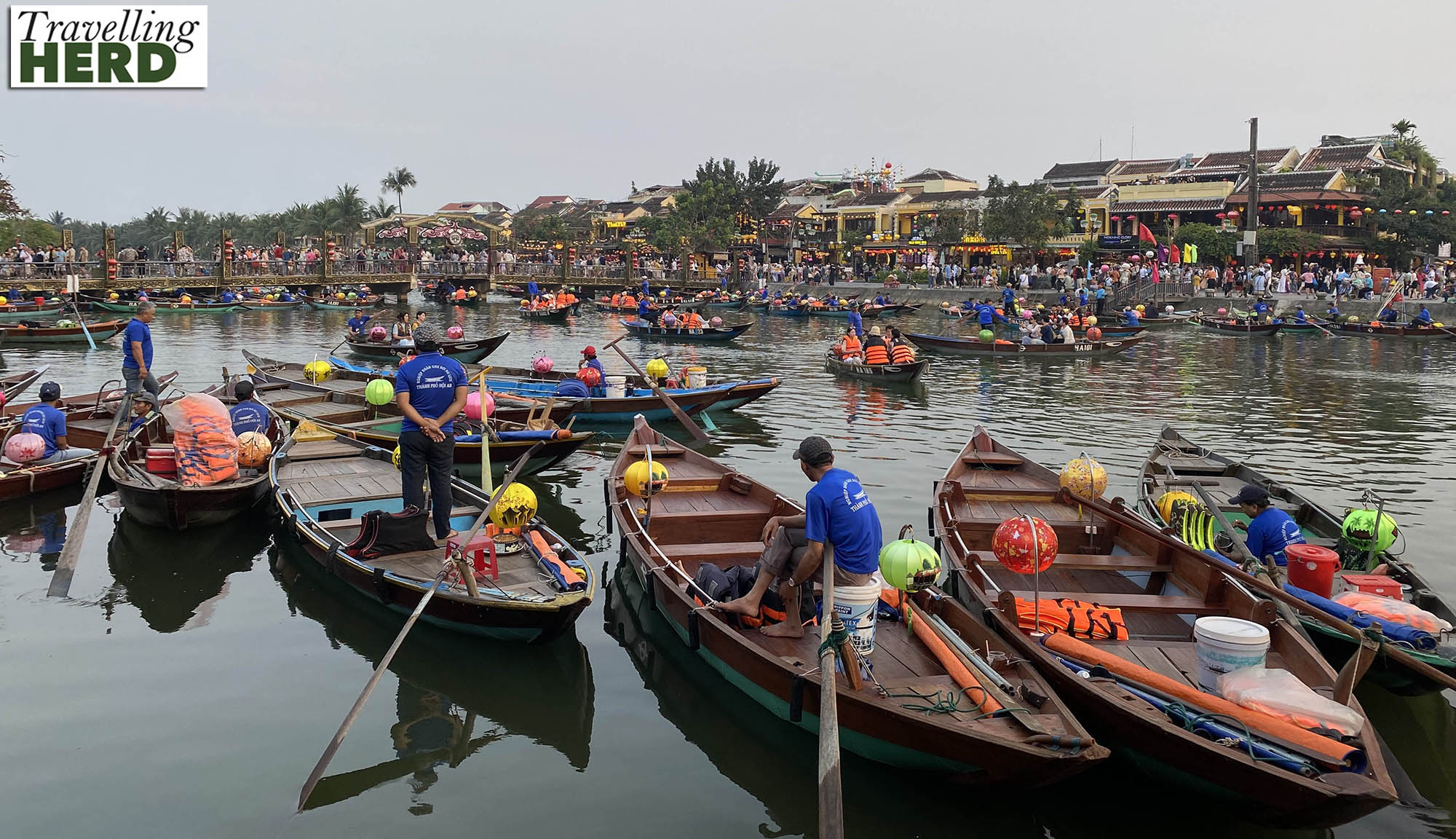
Walking back across An Hội Bridge over the Thu Bồn River the scene was again magical, although it was not yet the full moon celebration.
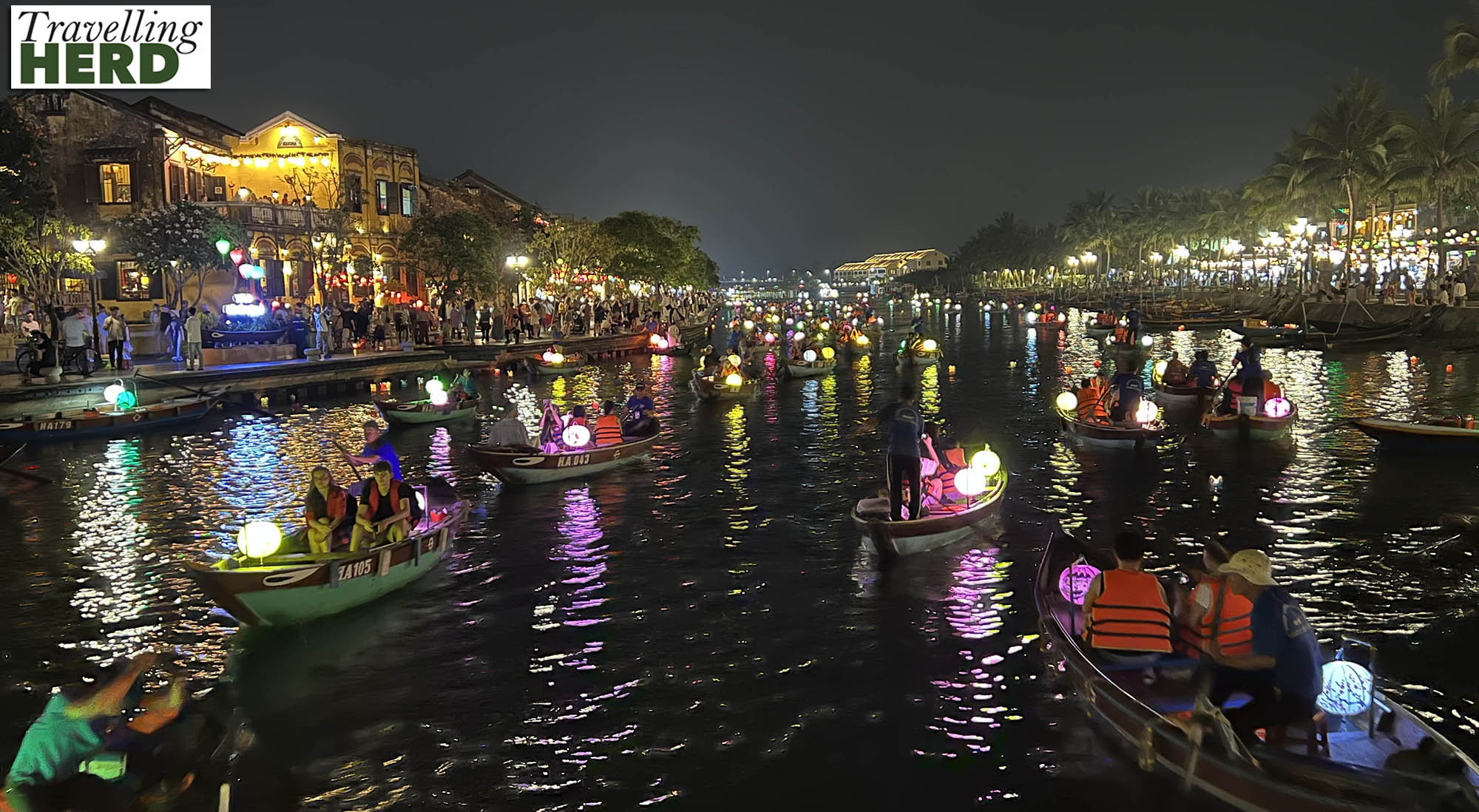
We walked beside the river and through the night market where stalls offered a mixture of street food, souvenirs and clothing. Matilda was quite taken with the coconut bowls which come in vibrant colours but did not want to carry anything extra so we went instead in search of rehydration.

Sitting in a riverside bar and people-watching we noticed how many couples had chosen to buy outfits made from the same material. Often couples would signify their commitment in this way but parents would also buy matching outfits for two or more children. However, we felt this family deserved a prize.
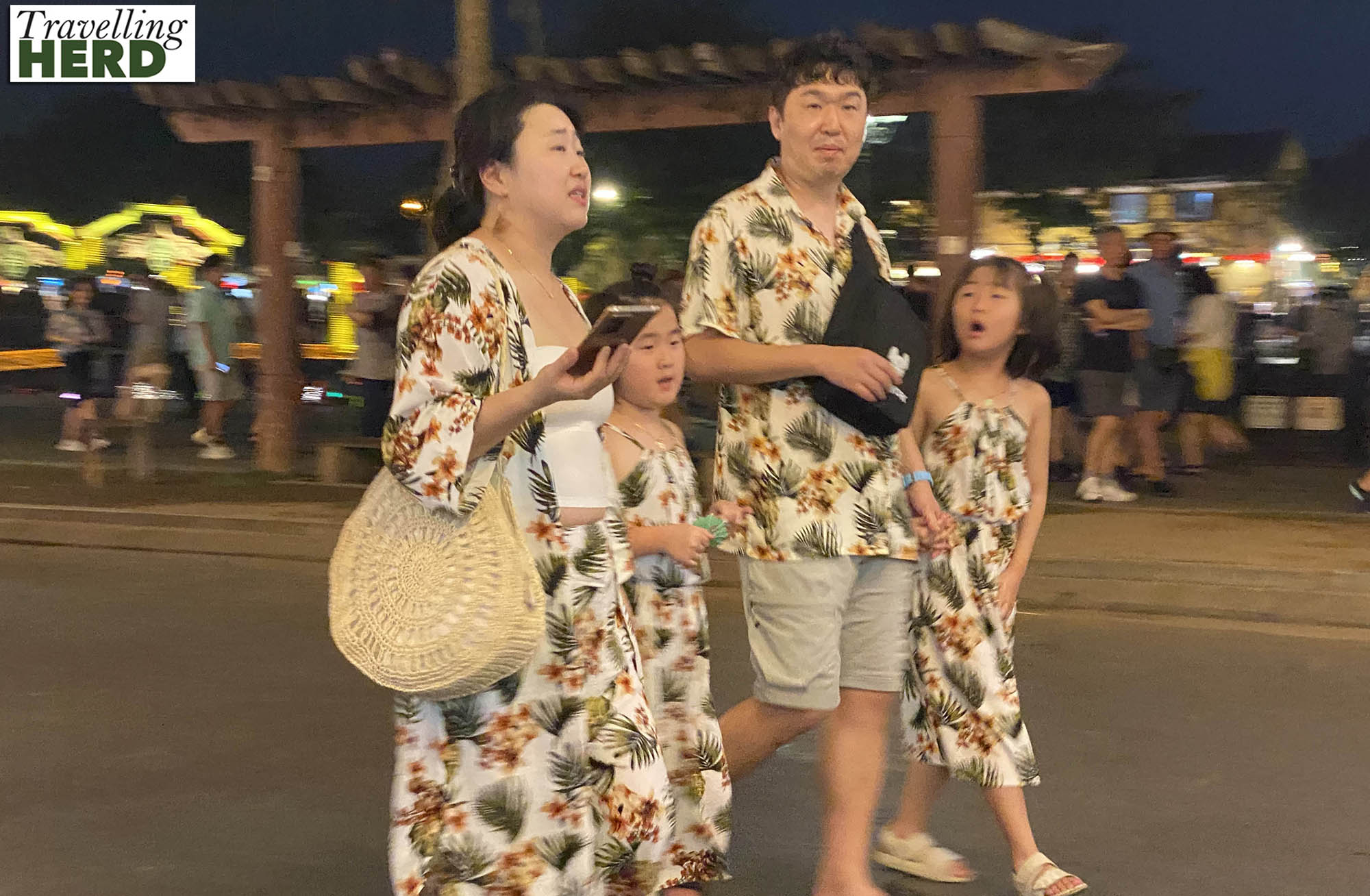
Robert had thoughtfully identified a bar which sold Matilda’s favourite Hoegaarden and we secured a table to quench our thirst and watch the traffic go by.
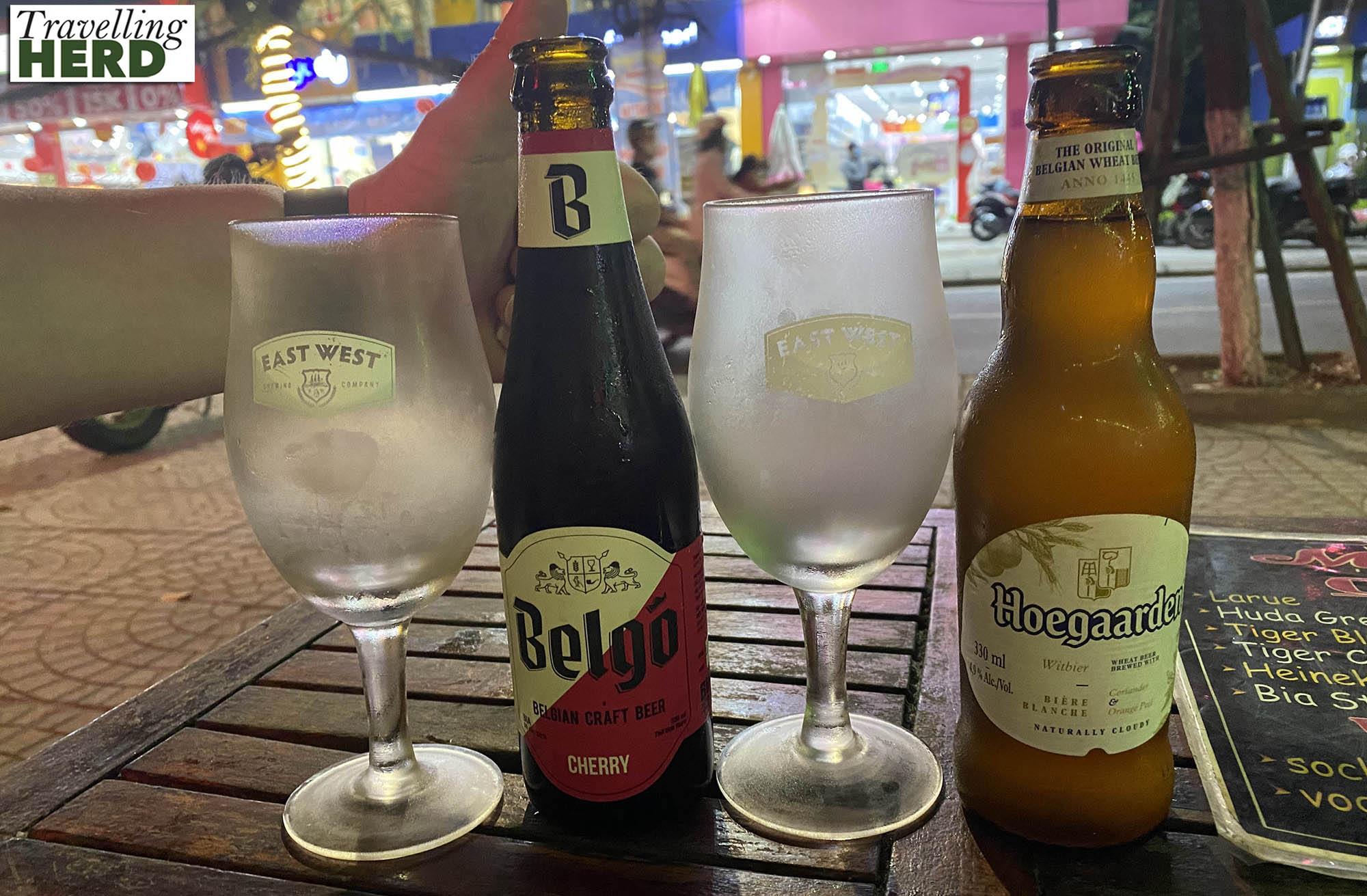
We have been enjoying trying to spot the most outrageous examples of mo-peds being overloaded or carrying inappropriate items. It is common for a family of four to travel on one mo-ped or to see large blocks of ice packaged up for transportation melting en route. Huge floral displays like shields on display stands are quite often transported by mo-ped as are lengths of building materials extending precariously to front and back. Some of our favourites though are the canine companions. Small dogs often ride at the driver’s feet while slightly larger ones command the handlebars with nonchalance.
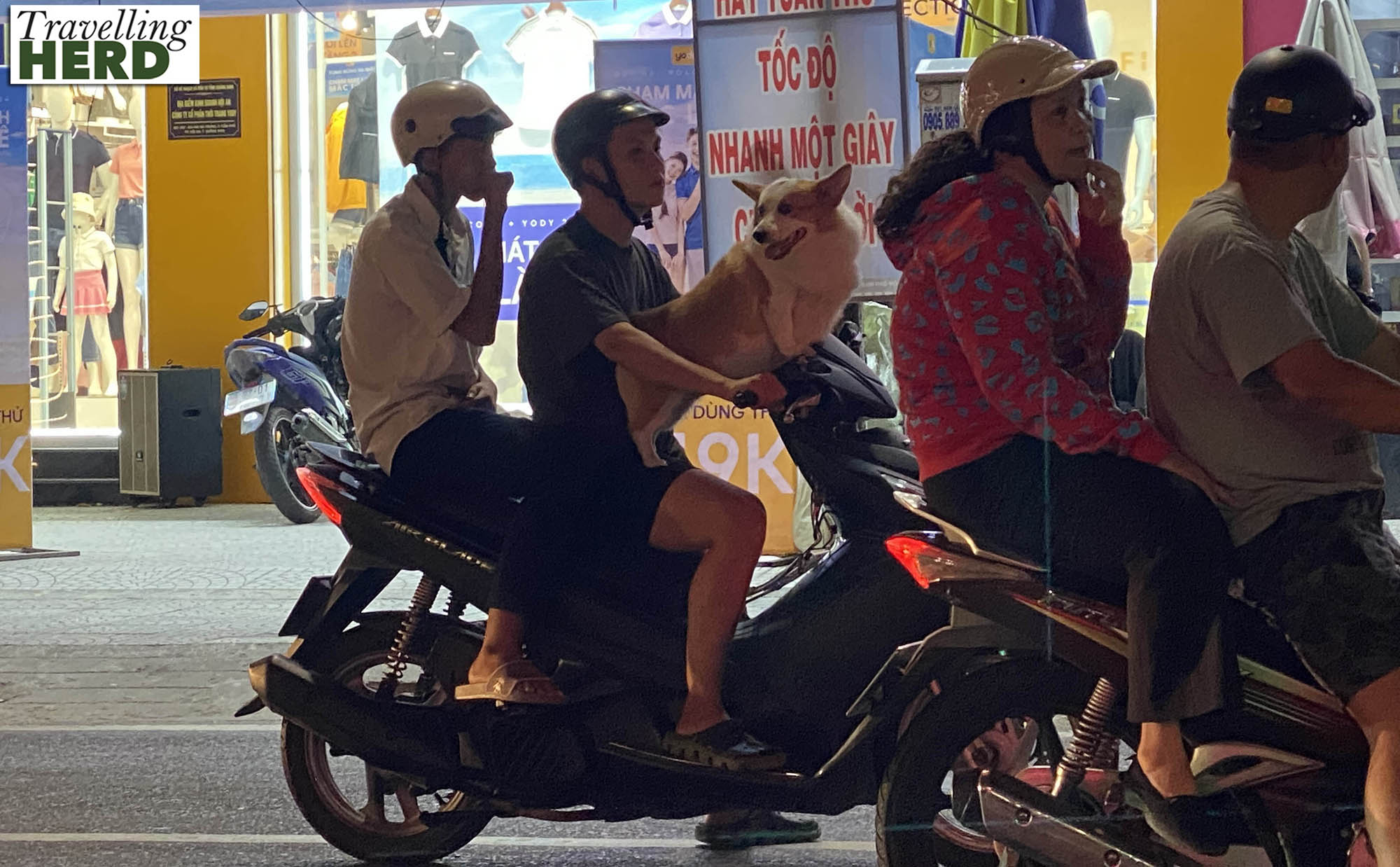
Video of the day:
Selfie of the day:
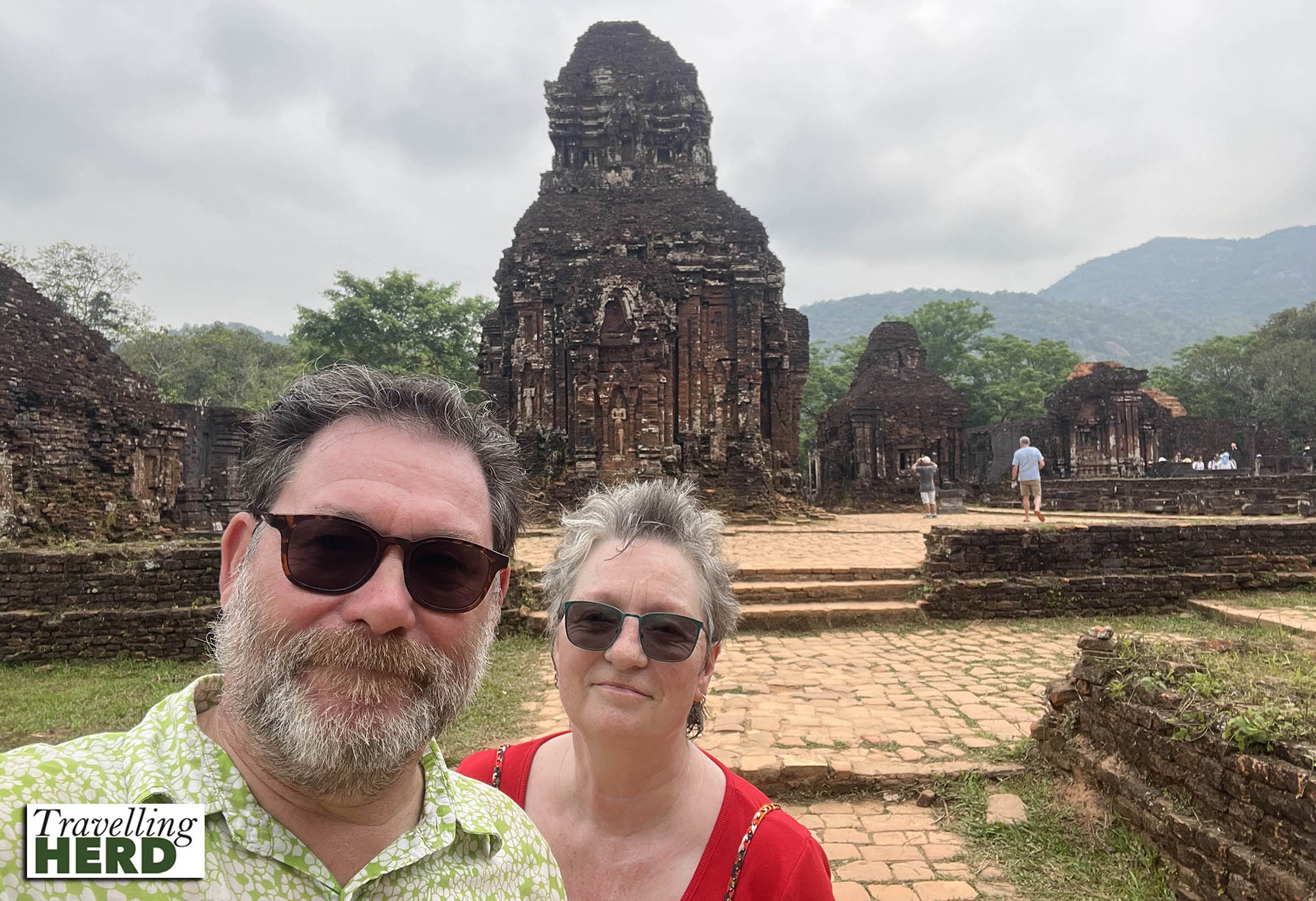
Route Map:
